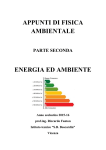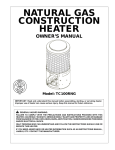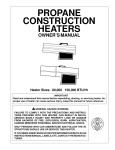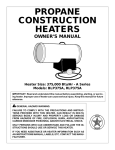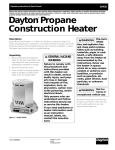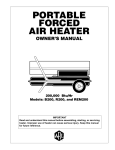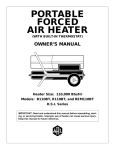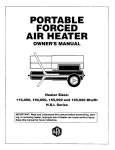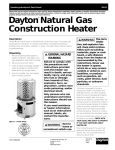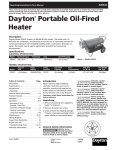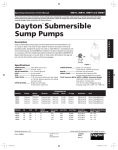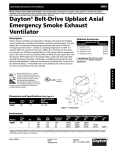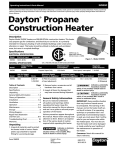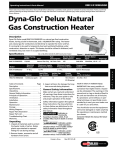Download Dayton 3VE56A Operating instructions
Transcript
3VE56A Operating Instructions & Parts Manual Please read and save these instructions. Read carefully before attempting to assemble, install, operate or maintain the product described. Protect yourself and others by observing all safety information. Failure to comply with instructions could result in personal injury and/or property damage! Retain instructions for future reference. Dayton Natural Gas Construction Heater ® Description Dayton model 3VE56A is a natural gas fired construction heater, having a builtin thermostat, and a 150,000 BTU/Hr rating. The heater uses natural gas for combustion and electricity to operate the motor and fan. It is primarily to be used to temporarily heat well-ventilated buildings under construction, alteration or repair. This heater should be utilized in sheltered, well-ventilated areas, but never in occupied dwellings. Specifications Figure 1 – Model 3VE56A Model Output Rating BTU/Hr Fuel Fuel Consumption Hot Air Output (CFM Approx) Motor Electric Motor Input Amperage 3VE56A 150,000 Natural Gas Only 150 Cubic Ft/Hr 435 3580 RPM 120V/60Hz, 1/9 HP 0.8 Model Manifold Pressure Maximum Supply Pressure to Heater Minimum Supply Pressure to Heater Temperature Control 3VE56A 3.3” W.C. 1/2 PSI 5” W.C. Built-In Thermostat Model Ignition 3VE56A Direct spark Table of Contents Page Description ·····························1 Specifications ··························1 Unpacking ·····························1 General Safety Information ········1-3 Principals of Operation ···············3 Ventilation ····························3 Installation ·····························4 Operation ·····························4 Maintenance ························4-5 Storage ································5 Wiring Diagram ·······················6 Troubleshooting Chart ················7 Repair Parts Illustration ···············8 Repair Parts List ·······················9 Warranty ·····························12 Unpacking 1. Unpack all materials used to protect the heater inside of carton. Retain plastic caps attached to exposed fittings for use during storage. 2. Remove heater, accessories and all hardware from carton. Form 5S4859 Weight (Pounds) Size L x W x H (Inches) 24 (Heater) 35 (Shipping) 25.1 x 8.9 x 15.9 3. Inspect all items for damage that may have occurred during shipment. If there is any damage, promptly inform the local Grainger branch where you purchased heater. General Safety Information Make certain you read and understand all warnings. Keep these instructions for reference. They are your guide to safe and proper operation of this heater. Safety information appears throughout these instructions. Pay close attention to them. Below are definitions for the safety information listed throughout this manual. Indicates an imminently hazardous situation which, if not avoided, WILL result in death or serious injury. Indicates a potentially hazardous situation which, if not avoided, MAY result in minor or moderate injury. IMPORTANT: Not every possible circumstance that might involve a hazard can be anticipated. The warnings in this manual and on tags or decals affixed to the unit are therefore not all-inclusive. If a procedure, work method, or operating technique not specifically recommended by Dayton is used, you must make sure it is safe for you and others. You should also ensure that equipment will not be damaged or made unsafe by the operating or maintenance method you choose. Consumer: Retain this manual for future reference. Indicates a potentially hazardous situation which, if not avoided, COULD result in death or serious injury. Printed in Korea 09663 0605/263/VCPVP PIN003 05/05 ® 3VE56A Dayton Operating Instructions and Parts Manual Dayton Natural Gas Construction Heater ® General Safety Information (Continued) General Hazard Warning: Failure to comply with the precautions and instructions provided with this heater can result in death, serious bodily injury, and property loss, or damage from hazards of fire, explosion, burn, asphyxiation, carbon monoxide poisoning, and/or electrical shock. Only persons who can understand and follow these instructions should use or service this heater. If you need assistance or heater information such as an instruction manual, labels, etc. contact your local Grainger branch. Fire, burn, inhalation, and explosion hazard. Keep solid combustibles such as building materials, paper, or cardboard, at a safe distance away from heater as recommended by the instructions. Never use the heater in spaces which do or may contain volatile or airborne combustibles or products such as gasoline, solvents, paint thinner, dust particles, or unknown chemicals. Proposition 65 Warning: Fuels used in gas, wood burning or oil-fired appliances, and the products of combustion of such fuels, contain chemicals known to the State of California to cause cancer, birth defects and other reproductive harm. Carbon monoxide poisoning may lead to death! Some people are more affected by carbon monoxide than others. Early signs of carbon monoxide poisoning resemble the flu, with headaches, dizziness, and/or nausea. If you have these signs, the heater may not be operating properly, or the areas may not be sufficiently ventilated. Get fresh air at once! Have heater serviced. Natural Gas: Natural gas has a distinctive odor. This odor helps you detect a natural gas leak. However, the odor may fade. Natural gas may be present even though no odor exists. Install and use heater with care. Follow all local ordinances and codes. In the absence of local ordinances and codes, refer to the National Fuel Gas Code handbook NFPA54/ANSI Z223.1 and the Natural Gas Installation Code, CAN/CGA B149.1. This instructs on the safe storage and handling of flammable gases. - Use only the electrical voltage and frequency specified on model plate. The electrical connections and grounding of the heater shall follow the National Electric Code, ANSI/NFPA 70 or the Canadian Electrical Code, Part 1. - Electrical grounding instructions - This appliance is equipped with a threeprong (grounding) plug for your protection against shock hazard and should be plugged directly into a properly grounded three-prong receptacle or extension cord. - Use only natural gas. Do not attempt to operate on LP gas. - Provide adequate ventilation. Before using heater, provide at least a threesquare-foot opening of fresh, outside air for each 100,000 Btu/Hr of rating. This heater produces carbon monoxide, which is listed by the State of California as a reproductive toxin under Proposition 65. 2 - For indoor use only. Do not use heater outdoors. - Do not use heater in occupied dwellings or in living or sleeping quarters. - Keep appliance area clear and free from combustible materials, gasoline, paint thinner, and other flammable vapors and liquids. Dust is combustible. Do not use heater in areas with high dust content. Minimum heater clearances from combustibles: Outlet: 8 Ft Sides: 2 Ft. Top: 6 Ft. Rear: 2 Ft. - Check heater for damage before each use. Do not use a damaged heater. - Check hose (if used) before each use of heater. If highly worn or cut, replace with hose specified by manufacturer before using heater. - Locate heater on stable and level surface if heater is hot or operating. - Never block air inlet (rear) or air outlet (front) of heater. - Never operate heater while unattended. - Keep heater away from strong drafts, wind, water spray, rain, or dripping water. - Keep children and animals away from heater. Dayton Operating Instructions and Parts Manual Model 3VE56A General Safety Information (Continued) Principals of Operation TEMPERATURE CONTROL SYSTEM FUEL SYSTEM - This heater is equipped with a thermostat. Heater may start at anytime. The pipe runs from the gas supply to the heater itself. After the gas runs through the pipe, it passes through the solenoid valve and out the nozzle into the combustion chamber. A built-in thermostat allows the heater to turn on and off to maintain a consistent temperature. - Never move, handle, or service a hot, or operating heater. Severe burns may result. You must wait 15 minutes after turning heater off. AIR SYSTEM - To prevent injury, wear gloves when handling heater. The internal motor turns the fan, which pushes air around and through the combustion chamber. Here the air is heated and provides a constant stream of warmth. - Never attach ductwork to heater. - Do not alter heater. Keep heater in its original state. IGNITION SYSTEM - Do not use heater if altered. The spark module sends voltage to the ignitor. The ignitor ignites the fuel and air mixture. - Turn off natural gas supply to heater and unplug when not in use. - Use only original replacement parts. This heater must use design-specific parts. Do not substitute or use generic parts. Improper replacement parts could cause serious or fatal injuries. SAFETY CONTROL SYSTEM This system shuts the heater down if the flame is extinguished. The fan and motor will continue to operate, but there will not be any heat. Ignitor Nozzle THE NATURAL GAS SUPPLY The user of this heater must provide the natural gas supply and all fittings to properly install the heater. The natural gas supply should be able to provide a minimum of 150 cubic feet of gas per hour for each heater being used. Consult with your natural gas supplier for the proper sizing of all gas lines. You must regulate the natural gas supply down from a minimum of 5 inches of water column to a maximum of 1/2 PSI. Be sure to research and follow all local ordinances and codes. In the absence of local codes, follow the National Fuel Gas Code Handbook NFPA54/ANSI Z223.1 and the Natural Gas Installation Code, CAN/CGA B149.1. Ventilation Fan Motor Guard Clean Heated Air Out (Front) Power Cord A three square foot opening of fresh outside air must be provided to operate each heater safely. If the proper air ventilation is not provided, carbon monoxide poisoning can occur. Always be sure that the proper ventilation is being provided before starting this heater. On/Off Switch Combustion Chamber Solenoid Valve Air Combustion and Heating PCB Control Fuel Regulator Spark Module (Spark Ignitor) Figure 2 – Cross Section Operational View ® 3 3VE56A Dayton Operating Instructions and Parts Manual Dayton Natural Gas Construction Heater ® Installation Review and understand all of the warnings in the Safety Information Section on pages 1–3. They are required to operate this heater safely. Follow all local and state codes when operating this heater. Be sure to test all connections for leaks after installation or service. Never use an open flame to check for leaks. Apply a 50/50 mixture of dish soap and water to each connection. If bubbles appear, there is a leak. Correct all leaks immediately. 1. Provide the natural gas supply system (See Natural Gas Supply, on page 3). 2. Connect all plumbing and fittings to the low-pressure Natural Gas source. This source must be regulated to a maximum of 1/2 PSI, and the piping must be a 3/4 inside diameter minimum, and not be over 10 feet in length. 3. Line up the female threaded end of the hose with the fitting on the heater base and tighten. 4. Slowly open valve at natural gas supply. 5. Check for leaks at all connections. After installing all gas piping, and making the proper connections, be sure to check for leaks. Apply a 50/50 mixture of dish soap and water to all connections. Bubbles forming are evidence of a leak. Be sure to correct all leaks at once! 6. Close natural gas supply. Operation Review and understand all of the warnings in the Safety Information Section on pages 1–3. They are required to operate this heater safely. Follow all local and state codes when operating this heater. TO START HEATER 1. Follow all safety, installation and ventilation instructions in this manual. 2. Position the heater on a stable and level surface, and be sure that no drafts blow into the inlet or outlet of the heater. Inlet Connector 5. Open gas supply valve slowly. 6. Rotate on/off switch to the ON position. Set thermostat to desired temperature. Thermostat setting may be too low if heater does not start. Select a higher temperature to start heater. NOTE: If the heater does not ignite, turn on/off switch to OFF position. Wait for the safety control to reset (usually about 10 seconds), and try again. NOTE: If this does not work, the high temperature switch may have opened while the thermostat was shutting down. Wait 10 to 15 minutes for the switch to reset, then attempt to light heater. Continued outages indicate a system problem, have unit serviced by a professional. TO SHUT DOWN HEATER 1. Shut off the gas supply by closing the valve tightly. 3. Plug the power cord of the heater into a three prong grounded extension cord. Be sure that the extension cord is at least 6 feet long, and is UL listed. 2. After a few seconds, the heater will burn off the gas that was left in the supply line. EXTENSION CORD WIRE SIZE REQUIREMENTS 4. Disconnect heater from power supply. • Up to 50 feet long, use 18 AWG rated cord. Hose 4. Following the extension cord requirements, plug the extension cord into a 120 volt/60 Hertz, three prong grounded outlet. • 51 to 100 feet long, use 16 AWG rated cord. • 101 to 200 feet long, use 14 AWG rated cord. Figure 3 – Hose and Inlet Connector 4 3. Turn on/off switch to the OFF position. Maintenance Do not attempt to service the heater while it is hot, operating or plugged in. Severe burns or electrical shock can occur. 1. Be sure to inspect the heater before each use. Check for leaks using the method described in Installation section. Repair any leaks immediately. Dayton Operating Instructions and Parts Manual Model 3VE56A Maintenance (Continued) FAN 2. Always keep heater clean. Clean the heater annually, or as often as needed to remove any dust or debris. When the heater becomes dirty, wipe it down with a damp cloth. IMPORTANT: Make sure not to bend the fan blades when removing Guard with Fan Motor Assembly from Heater. This will help prevent damage to the fan. 3. Keep the inside of the heater free from foreign objects and combustibles. 4. Have the heater inspected annually by a qualified service person. SERVICE PROCEDURES Never service heater while hot, operating or connected to the gas supply. Severe burns or electrical shock may occur. REMOVING PROTECTIVE COVER 1. Remove base cover at the bottom of the heater by removing two screws. Guard (with Fan Motor Assembly) Washer Fan Flange Hex Nut 1. Remove base cover by removing two screws. Motor 2. Remove four screws from Guard. 3. Disconnect lead wires attached to the motor from Plug Housing. 4. Remove Guard with Fan Motor Assembly carefully. 5. Loosen fan setscrew using a 1/8” hex wrench, and remove fan. 6. Using a soft cloth moistened with kerosene or a cleaning solvent, carefully clean the fan blades making sure not to bend them. Figure 5 – Fan Motor Shaft, Hex Nut Location IGNITOR The only maintenance necessary for the ignitor is to be sure that the gap between the electrodes is kept between .13” and .15”. The ignitor is accessible through the combustion chamber. Storage Always disconnect heater from gas 7. Dry fan with clean cloth. supply. 8. Assemble fan on motor shaft and tighten hex nuts firmly (be careful not to overtighten). 1. Replace the plastic caps over the fittings they were installed when you originally unpacked your heater. 9. Reconnect lead wires as shown in the Wiring Diagram (Figure 6). 2. Store the heater in a safe, clean and dry location. 10. Reassemble guard and base cover. 3. When removing the heater from storage, always check inside of the heater for any foreign objects left by spiders or small animals. Keep the inside of the heater clean from foreign objects and combustibles. Base Base Cover Figure 4 – Protective Cover Removal ® 5 3VE56A Dayton Operating Instructions and Parts Manual Dayton Natural Gas Construction Heater ® Wiring Diagrams Figure 6 – Wiring Diagram 6 3VE56A Dayton Operating Instructions and Parts Manual Dayton Natural Gas Construction Heater ® Troubleshooting Chart Symptom Possible Cause(s) Corrective Action Fan does not turn when electrical connection is made 1. No electric power to heater 1. Check current to electric outlet. If voltage is correct, check power cord and extension cord for cuts and breaks 2. Be sure that housing is not damaged. Make sure there are no obstructions to the fan 3. Straighten blade(s) to match others 4. Replace motor 1. Check igniter wire. Reattach or tighten if loose. Check spark module. Replace if necessary. Check all electrical components 2. Set gap to 0.16” 3. Replace spark plug 4. Wait for five(5) minutes until limit switch returns to a normal condition. 1. If the heaters output is restricted, internal temperature becomes too high. Move heater away from any obstructions 2. Replace control valve 3. Clean inside of heater 2. Fan blade contacts inside of heater housing 3. Fan blade(s) bent 4. Fan motor defective Heater will not fire 1. No spark at igniter Heater quits while running 2. Improper spark gap 3. Bad electrode 4. Internal temperature too high causing limit switch to shut down operation. 1. Internal temperature too high causing limit switch to shut down operation 2. Damaged control valve 3. Dust or debris build-up inside of heater Always be sure to follow proper maintenance procedures, by cleaning the heater once per month during regular usage, and check spark gap at least once per season. ® 7 8 10 2 22 13 11 23 9 12 30 14 24 6 7 8 28 26 25 Figure 7 – Repair Parts Illustration for Natural Gas Construction Heater Address parts correspondence to: Grainger Parts P.O. Box 3074 1657 Shermer Road Northbrook, IL 60065-3074 U.S.A. Please provide following information: -Model number -Serial number (if any) -Part description and number as shown in parts list 24 hours a day – 365 days a year 27 15 29 For Repair Parts, call 1-800-323-0620 Dayton Operating Instructions and Parts Manual 1 4 3 31 16 5 32 17 36 35 20 34 18 19 33 21 3VE56A 3VE56A Dayton Operating Instructions and Parts Manual Models 3VE56A Repair Parts List for Natural Gas Construction Heater Reference Number Description Part Number for Models: 3VE56A 1 2 3 4 5 6 7 8 9 10 11 12 13 14 15 16 17 18 19 20 21 22 23 24 25 26 27 28 29 30 31 32 33 34 35 36 Outer Shell Inner Shell Ass’y Base Height Controller Base Cover Inner Shell Cap MULTI BKT Ass’y Thermal Swich Tubing Ass’y Main Nozzle Cap Nozzle Nozzle Nut Sensor Plug BKT Ass’y Sensor Cable Thermal Switch Cable Handle Flange Hexa Nut Fan Cushion Pad Motor Ass’y Guard Outlet Connector Regulator Middle Connector Solenoid Inlet Connector Round Bolt PCB PCB Case Solenoid Cable Spark Module Thermostat Power Cord Ass’y Thermostat Knob Special Hexa Bolt On-Off Switch 22-524-0010 22-524-0005 22-501-0005 22-512-0004 22-508-0004 22-505-0004 22-504-0004 22-603-0002 22-605-0004 22-505-0005 22-081-0005 22-518-0002 22-504-0005 22-601-0003 22-601-0002 22-511-0002 22-518-0003 22-514-0002 22-509-0001 22-061-0002 22-101-0004 22-507-0004 22-031-0001 22-507-0005 22-014-0001 22-507-0002 22-503-0003 22-521-0003 22-506-0002 22-601-0004 22-604-0002 22-012-0001 22-131-0002 22-516-0002 22-131-0001 22-603-0004 Quantity 1 1 1 1 1 1 1 1 1 1 1 1 1 1 1 1 1 1 1 1 1 1 1 1 1 1 1 1 1 1 1 1 1 1 2 1 ® 9 3VE56A Dayton Operating Instructions and Parts Manual Notes ® 10 3VE56A Dayton Operating Instructions and Parts Manual Notes ® 11 Dayton Operating Instructions and Parts Manual 3VE56A Dayton Natural Gas Construction Heater ® LIMITED WARRANTY DAYTON ONE-YEAR LIMITED WARRANTY. Dayton® Natural Gas Construction Heater, Model covered in this manual, is warranted by Dayton Electric Mfg. Co. (Dayton) to the original user against defects in workmanship or materials under normal use for one year after date of purchase. Any part which is determined to be defective in material or workmanship and returned to an authorized service location, as Dayton designates, shipping costs prepaid, will be, as the exclusive remedy, repaired or replaced at Dayton’s option. For limited warranty claim procedures, see PROMPT DISPOSITION below. This limited warranty gives purchasers specific legal rights which vary from jurisdiction to jurisdiction. LIMITATION OF LIABILITY. To the extent allowable under applicable law, Dayton’s liability for consequential and incidental damages is expressly disclaimed. Dayton’s liability in all events is limited to and shall not exceed the purchase price paid. WARRANTY DISCLAIMER. Dayton has made a diligent effort to provide product information and illustrate the products in this literature accurately; however, such information and illustrations are for the sole purpose of identification, and do not express or imply a warranty that the products are MERCHANTABLE, or FIT FOR A PARTICULAR PURPOSE, or that the products will necessarily conform to the illustrations or descriptions. Except as provided below, no warranty or affirmation of fact, expressed or implied, other than as stated in the “LIMITED WARRANTY” above is made or authorized by Dayton. PRODUCT SUITABILITY. Many jurisdictions have codes and regulations governing sales, construction, installation, and/or use of products for certain purposes, which may vary from those in neighboring areas. While Dayton attempts to assure that its products comply with such codes, it cannot guarantee compliance, and cannot be responsible for how the product is installed or used. Before purchase and use of a product, review the product applications, and all applicable national and local codes and regulations, and be sure that the product, installation, and use will comply with them. Certain aspects of disclaimers are not applicable to consumer products; e.g., (a) some jurisdictions do not allow the exclusion or limitation of incidental or consequential damages, so the above limitation or exclusion may not apply to you; (b) also, some jurisdictions do not allow a limitation on how long an implied warranty lasts, consequentially the above limitation may not apply to you; and (c) by law, during the period of this Limited Warranty, any implied warranties of implied merchantability or fitness for a particular purpose applicable to consumer products purchased by consumers, may not be excluded or otherwise disclaimed. PROMPT DISPOSITION. Dayton will make a good faith effort for prompt correction or other adjustment with respect to any product which proves to be defective within limited warranty. For any product believed to be defective within limited warranty, first write or call dealer from whom the product was purchased. Dealer will give additional directions. If unable to resolve satisfactorily, write to Dayton at address below, giving dealer’s name, address, date, and number of dealer’s invoice, and describing the nature of the defect. Title and risk of loss pass to buyer on delivery to common carrier. If product was damaged in transit to you, file claim with carrier. Manufactured for Dayton Electric Mfg. Co., 5959 W. Howard St., Niles, Illinois 60714 U.S.A. Manufactured for Dayton Electric Mfg. Co. Niles, Illinois 60714 U.S.A. ®












